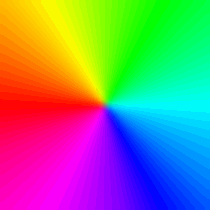GIF
(Redirected from Graphics Interchange Format)
Graphics Interchange Format (GIF) is a bitmap image format widely used on the Internet for its flexible web support and portability. Developed by CompuServe in 1987, the format has come to be recognized by its support for animated graphics. Its ability to support up to 256 colors makes it suitable for simpler images such as icons and logos with solid areas of color.
History[edit | edit source]
The GIF format was introduced by CompuServe in 1987 to provide a color image format for their file downloading areas, replacing their earlier run-length encoding (RLE) format, which was black and white only. GIF became popular due to its wide support and portability, which was unmatched by other formats at the time.
Format Specifications[edit | edit source]
GIF uses the Lempel–Ziv–Welch (LZW) lossless data compression technique to reduce the file size without degrading the visual quality. This compression technique was a key factor in the format's popularity. GIF supports up to 8 bits per pixel for each image, allowing a single image to reference its own palette of up to 256 different colors chosen from the 24-bit RGB color space. It also supports animations and allows a separate palette of up to 256 colors for each frame.
Usage[edit | edit source]
GIF is widely used for its ability to support animated images. It is a popular format for Internet memes and short animations. Despite the rise of more advanced formats like Portable Network Graphics (PNG) for static images and WebM or MP4 for animations, GIF remains a popular choice due to its simplicity and widespread support across web browsers and image viewers.
Limitations[edit | edit source]
The main limitation of the GIF format is its color depth. Being limited to 256 colors, it is not suitable for color photographs or images with gradients. This limitation can lead to dithering in images, where patterns of dots are used to simulate additional colors. Additionally, while GIF supports animation, it does not support sound, limiting its use for multimedia presentations.
Alternatives[edit | edit source]
With the limitations of GIF in mind, several alternative formats have been developed:
- Portable Network Graphics (PNG) offers better compression and more colors but does not support animation.
- JPEG is better suited for photographs due to its support for millions of colors.
- WebP, developed by Google, supports both lossless and lossy compression, providing a good alternative for both static images and animations.
- APNG (Animated PNG) extends PNG to offer animation capabilities.
See Also[edit | edit source]
Search WikiMD
Ad.Tired of being Overweight? Try W8MD's physician weight loss program.
Semaglutide (Ozempic / Wegovy and Tirzepatide (Mounjaro / Zepbound) available.
Advertise on WikiMD
|
WikiMD's Wellness Encyclopedia |
| Let Food Be Thy Medicine Medicine Thy Food - Hippocrates |
Translate this page: - East Asian
中文,
日本,
한국어,
South Asian
हिन्दी,
தமிழ்,
తెలుగు,
Urdu,
ಕನ್ನಡ,
Southeast Asian
Indonesian,
Vietnamese,
Thai,
မြန်မာဘာသာ,
বাংলা
European
español,
Deutsch,
français,
Greek,
português do Brasil,
polski,
română,
русский,
Nederlands,
norsk,
svenska,
suomi,
Italian
Middle Eastern & African
عربى,
Turkish,
Persian,
Hebrew,
Afrikaans,
isiZulu,
Kiswahili,
Other
Bulgarian,
Hungarian,
Czech,
Swedish,
മലയാളം,
मराठी,
ਪੰਜਾਬੀ,
ગુજરાતી,
Portuguese,
Ukrainian
Medical Disclaimer: WikiMD is not a substitute for professional medical advice. The information on WikiMD is provided as an information resource only, may be incorrect, outdated or misleading, and is not to be used or relied on for any diagnostic or treatment purposes. Please consult your health care provider before making any healthcare decisions or for guidance about a specific medical condition. WikiMD expressly disclaims responsibility, and shall have no liability, for any damages, loss, injury, or liability whatsoever suffered as a result of your reliance on the information contained in this site. By visiting this site you agree to the foregoing terms and conditions, which may from time to time be changed or supplemented by WikiMD. If you do not agree to the foregoing terms and conditions, you should not enter or use this site. See full disclaimer.
Credits:Most images are courtesy of Wikimedia commons, and templates, categories Wikipedia, licensed under CC BY SA or similar.
Contributors: Prab R. Tumpati, MD




